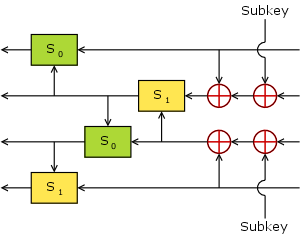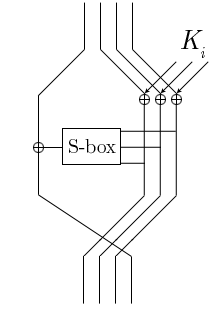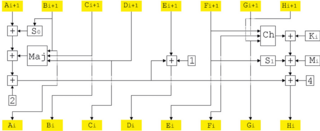In cryptography, a block cipher is a deterministic algorithm operating on fixed-length groups of bits, called blocks. Block ciphers are specified elementary components in the design of many cryptographic protocols and are widely used to encrypt large amounts of data, including in data exchange protocols. A block cipher uses blocks as an unvarying transformation.

The Data Encryption Standard is a symmetric-key algorithm for the encryption of digital data. Although its short key length of 56 bits makes it too insecure for modern applications, it has been highly influential in the advancement of cryptography.
Differential cryptanalysis is a general form of cryptanalysis applicable primarily to block ciphers, but also to stream ciphers and cryptographic hash functions. In the broadest sense, it is the study of how differences in information input can affect the resultant difference at the output. In the case of a block cipher, it refers to a set of techniques for tracing differences through the network of transformation, discovering where the cipher exhibits non-random behavior, and exploiting such properties to recover the secret key.

In cryptography, the International Data Encryption Algorithm (IDEA), originally called Improved Proposed Encryption Standard (IPES), is a symmetric-key block cipher designed by James Massey of ETH Zurich and Xuejia Lai and was first described in 1991. The algorithm was intended as a replacement for the Data Encryption Standard (DES). IDEA is a minor revision of an earlier cipher Proposed Encryption Standard (PES).
In cryptography, linear cryptanalysis is a general form of cryptanalysis based on finding affine approximations to the action of a cipher. Attacks have been developed for block ciphers and stream ciphers. Linear cryptanalysis is one of the two most widely used attacks on block ciphers; the other being differential cryptanalysis.
In cryptography, Lucifer was the name given to several of the earliest civilian block ciphers, developed by Horst Feistel and his colleagues at IBM. Lucifer was a direct precursor to the Data Encryption Standard. One version, alternatively named DTD-1, saw commercial use in the 1970s for electronic banking.

In cryptography, XTEA is a block cipher designed to correct weaknesses in TEA. The cipher's designers were David Wheeler and Roger Needham of the Cambridge Computer Laboratory, and the algorithm was presented in an unpublished technical report in 1997. It is not subject to any patents.

In cryptography, FEAL is a block cipher proposed as an alternative to the Data Encryption Standard (DES), and designed to be much faster in software. The Feistel based algorithm was first published in 1987 by Akihiro Shimizu and Shoji Miyaguchi from NTT. The cipher is susceptible to various forms of cryptanalysis, and has acted as a catalyst in the discovery of differential and linear cryptanalysis.

In cryptography, LOKI97 is a block cipher which was a candidate in the Advanced Encryption Standard competition. It is a member of the LOKI family of ciphers, with earlier instances being LOKI89 and LOKI91. LOKI97 was designed by Lawrie Brown, assisted by Jennifer Seberry and Josef Pieprzyk.
In cryptography, LOKI89 and LOKI91 are symmetric-key block ciphers designed as possible replacements for the Data Encryption Standard (DES). The ciphers were developed based on a body of work analysing DES, and are very similar to DES in structure. The LOKI algorithms were named for Loki, the god of mischief in Norse mythology.

In cryptography, MacGuffin is a block cipher created in 1994 by Bruce Schneier and Matt Blaze at a Fast Software Encryption workshop. It was intended as a catalyst for analysis of a new cipher structure, known as Generalized Unbalanced Feistel Networks (GUFNs). The cryptanalysis proceeded very quickly, so quickly that the cipher was broken at the same workshop by Vincent Rijmen and Bart Preneel.
In cryptography, Madryga is a block cipher published in 1984 by W. E. Madryga. It was designed to be easy and efficient for implementation in software. Serious weaknesses have since been found in the algorithm, but it was one of the first encryption algorithms to make use of data-dependent rotations, later used in other ciphers, such as RC5 and RC6.

SHACAL-1 is a 160-bit block cipher based on SHA-1, and supports keys from 128-bit to 512-bit. SHACAL-2 is a 256-bit block cipher based upon the larger hash function SHA-256.

In cryptography, ICE is a symmetric-key block cipher published by Kwan in 1997. The algorithm is similar in structure to DES, but with the addition of a key-dependent bit permutation in the round function. The key-dependent bit permutation is implemented efficiently in software. The ICE algorithm is not subject to patents, and the source code has been placed into the public domain.
In cryptography, an interpolation attack is a type of cryptanalytic attack against block ciphers.
In cryptography, SC2000 is a block cipher invented by a research group at Fujitsu Labs. It was submitted to the NESSIE project, but was not selected. It was among the cryptographic techniques recommended for Japanese government use by CRYPTREC in 2003, however, has been dropped to "candidate" by CRYPTREC revision in 2013.
In cryptography, DFC is a symmetric block cipher which was created in 1998 by a group of researchers from École Normale Supérieure, CNRS, and France Télécom and submitted to the AES competition.
In cryptography, M8 is a block cipher designed by Hitachi in 1999. It is a modification of Hitachi's earlier M6 algorithm, designed for greater security and high performance in both hardware and 32-bit software implementations. M8 was registered by Hitachi in March 1999 as ISO/IEC 9979-0020.

Speck is a family of lightweight block ciphers publicly released by the National Security Agency (NSA) in June 2013. Speck has been optimized for performance in software implementations, while its sister algorithm, Simon, has been optimized for hardware implementations. Speck is an add–rotate–xor (ARX) cipher.

Simon is a family of lightweight block ciphers publicly released by the National Security Agency (NSA) in June 2013. Simon has been optimized for performance in hardware implementations, while its sister algorithm, Speck, has been optimized for software implementations.










